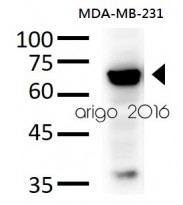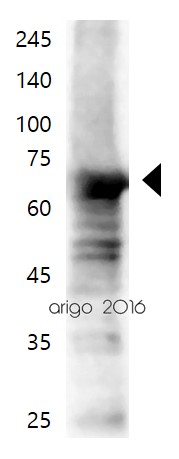ARG54149
anti-c-Fos antibody
anti-c-Fos antibody for Western blot and Human,Mouse,Rat,Monkey
Cancer antibody; Gene Regulation antibody; Neuroscience antibody; AP-1 early response transcription factor study antibody

2
Overview
| Product Description | Mouse Monoclonal antibody recognizes C-FOS |
|---|---|
| Tested Reactivity | Hu, Ms, Rat, Mk |
| Tested Application | WB |
| Host | Mouse |
| Clonality | Monoclonal |
| Isotype | IgG1 |
| Target Name | c-Fos |
| Antigen Species | Human |
| Immunogen | Purified recombinant human FOS protein fragments expressed in E.coli. |
| Conjugation | Un-conjugated |
| Alternate Names | Proto-oncogene c-Fos; C-FOS; AP-1; Cellular oncogene fos; p55; G0/G1 switch regulatory protein 7 |
Application Instructions
| Application Suggestion |
|
||||
|---|---|---|---|---|---|
| Application Note | * The dilutions indicate recommended starting dilutions and the optimal dilutions or concentrations should be determined by the scientist. |
Properties
| Form | Liquid |
|---|---|
| Purification | Affinity purified |
| Buffer | PBS (pH 7.4), 0.02% Sodium azide and 50% Glycerol |
| Preservative | 0.02% Sodium azide |
| Stabilizer | 50% Glycerol |
| Concentration | 1 mg/ml |
| Storage Instruction | For continuous use, store undiluted antibody at 2-8°C for up to a week. For long-term storage, aliquot and store at -20°C. Storage in frost free freezers is not recommended. Avoid repeated freeze/thaw cycles. Suggest spin the vial prior to opening. The antibody solution should be gently mixed before use. |
| Note | For laboratory research only, not for drug, diagnostic or other use. |
Bioinformation
| Database Links | |
|---|---|
| Gene Symbol | FOS |
| Gene Full Name | FBJ murine osteosarcoma viral oncogene homolog |
| Background | Nuclear phosphoprotein which forms a tight but non-covalently linked complex with the JUN/AP-1 transcription factor.In the heterodimer,FOS and JUN/AP-1 basic regions each seems to interact with symmetrical DNA half sites.On TGF-beta activation,forms a multimeric SMAD3/SMAD4/JUN/FOS complex at the AP1/SMAD-binding site to regulate TGF-beta-mediated signaling.Has a critical function in regulating the development of cells destined to form and maintain the skeleton.It is thought to have an important role in signal transduction,cell proliferation and differentiation.In growing cells,activates phospholipid synthesis,possibly by activating CDS1 and PI4K2A.This activity requires Tyr-dephosphorylation and association with the endoplasmic reticulum. |
| Function | Nuclear phosphoprotein which forms a tight but non-covalently linked complex with the JUN/AP-1 transcription factor. In the heterodimer, FOS and JUN/AP-1 basic regions each seems to interact with symmetrical DNA half sites. On TGF-beta activation, forms a multimeric SMAD3/SMAD4/JUN/FOS complex at the AP1/SMAD-binding site to regulate TGF-beta-mediated signaling. Has a critical function in regulating the development of cells destined to form and maintain the skeleton. It is thought to have an important role in signal transduction, cell proliferation and differentiation. In growing cells, activates phospholipid synthesis, possibly by activating CDS1 and PI4K2A. This activity requires Tyr-dephosphorylation and association with the endoplasmic reticulum. [UniProt] |
| Cellular Localization | Nucleus. Endoplasmic reticulum. Cytoplasm > cytosol. |
| Highlight | Related Antibody Duos and Panels: ARG30265 AP-1 early response transcription factor Antibody Duo (c-Jun, c-Fos) Related products: c-Fos antibodies; c-Fos Duos / Panels; Anti-Mouse IgG secondary antibodies; |
| Research Area | Cancer antibody; Gene Regulation antibody; Neuroscience antibody; AP-1 early response transcription factor study antibody |
| Calculated MW | 41 kDa |
| PTM | Phosphorylated in the C-terminal upon stimulation by nerve growth factor (NGF) and epidermal growth factor (EGF). Phosphorylated, in vitro, by MAPK and RSK1. Phosphorylation on both Ser-362 and Ser-374 by MAPK1/2 and RSK1/2 leads to protein stabilization with phosphorylation on Ser-374 being the major site for protein stabilization on NGF stimulation. Phosphorylation on Ser-362 and Ser-374 primes further phosphorylations on Thr-325 and Thr-331 through promoting docking of MAPK to the DEF domain. Phosphorylation on Thr-232, induced by HA-RAS, activates the transcriptional activity and antagonizes sumoylation. Phosphorylation on Ser-362 by RSK2 in osteoblasts contributes to osteoblast transformation (By similarity). Constitutively sumoylated with SUMO1, SUMO2 and SUMO3. Desumoylated by SENP2. Sumoylation requires heterodimerization with JUN and is enhanced by mitogen stimulation. Sumoylation inhibits the AP-1 transcriptional activity and is, itself, inhibited by Ras-activated phosphorylation on Thr-232. In quiescent cells, the small amount of FOS present is phosphorylated at Tyr-10 and Tyr-30 by SRC. This Tyr-phosphorylated form is cytosolic. In growing cells, dephosphorylated by PTPN2. Dephosphorylation leads to the association with endoplasmic reticulum membranes and activation of phospholipid synthesis. |
Images (1) Click the Picture to Zoom In
Customer's Feedback

 Good
Good

 Excellent
Excellent





